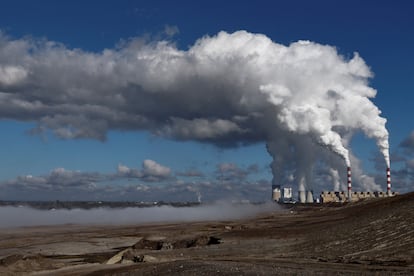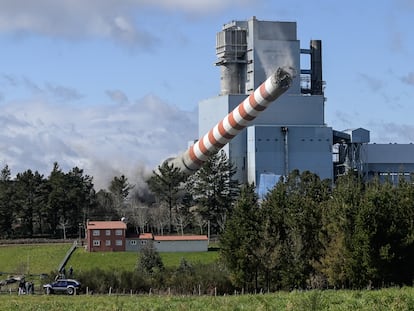Only 4% of countries propose eliminating multibillion-dollar subsidies for fossil fuels in their climate plans
Global greenhouse gas emissions will peak this decade. However, the U.N. warns that, even with no further increases, this will not be enough to avoid a ‘climate catastrophe’


Every year, governments shower hundreds of billions of public money on the fossil fuel sector around the world. This is despite the fact that coal, oil and gas are mainly responsible for the climate crisis, which has led the planet to an exceptional situation.
Eliminating this aid is a long-standing demand in the fight against climate change. In the final declaration of the U.N. Climate Change Conference in Glasgow, held at the end of 2021 in the Scottish city, the nearly 200 countries that participated in the event (practically the entire world) included an explicit call to gradually eliminate inefficient public aid to the fossil fuel sector. However, that call from two years ago hasn’t been transformed into concrete commitments in national climate action plans, as revealed this week by a report from the U.N., which also warns that efforts to ensure that global warming remains within the safest limits are still insufficient. The study warns that while greenhouse gas emissions will peak before the end of the decade, they will not be reduced quickly and intensely enough.
Two weeks before the start of the annual climate summit in Dubai — COP28 — this U.N. analysis examines the plans of the 194 countries that have signed the Paris Agreement. When a nation signs this pact, it must present a document that includes the measures it’s applying to address global warming. In these plans, the vast majority of states commit to reduce their greenhouse gas emissions and promote renewable energy. But only 4% of the 194 countries that are party to the agreement include direct references to the gradual elimination of public aid for fossil fuels, which are mainly responsible for emissions.
That 4% — seven countries in all — doesn’t even represent 4% of the total public aid that is given to the oil, gas or coal industries each year in the world. The report also doesn’t mention which nations have made this commitment. But the important thing isn’t those who do it, but those who don’t. The policy of ending these subsidies is notoriously absent from the climate plans of the main greenhouse gas-emitting powers — that is, China, the United States and India. And, on October 16, the EU authorities presented an update of the bloc’s climate plan, which didn’t include any mention of the elimination of subsidies that fuel the climate crisis.
Quantifying the total amount of aid that goes towards fuel production and consumption is complicated. In 2021, $732 billion dollars of public money in the 82 largest economies in the world went directly to this sector, according to data provided by the OECD. But the IMF — in another report from this past August — reports that public aid for the fossil fuel sector actually reached $7 trillion in 2022. The IMF analysis was based on data from 170 countries. This massive figure also includes a large amount of public money that IMF experts explain has been taken by this sector indirectly. For example, the report includes certain healthcare expenses incurred by states, due to the health problems caused by fossil fuels. In any case, both reports conclude that this aid is substantial and — far from being reduced — has increased significantly since 2020.
Ending these subsidies would have direct climate benefits. In the analysis released this past Tuesday, U.N. experts emphasize that the Intergovernmental Panel on Climate Change (IPCC) has established that “the elimination of fossil fuel subsidies will lead to a reduction of global greenhouse gas emissions of up to 10% by 2030, in addition to generating other environmental and financial benefits.”
The wrong path forward
The U.N. report is one of the most important working documents for the summit that begins this November 30 in Dubai, because it allows us to monitor the evolution of measures and commitments in the fight against global warming. Every year, before these summits, the balance is presented, along with updates to national climate action plans (on this occasion, 20 programs have been updated). And the main conclusion is, once again, the same as in previous editions of the summit: progress is being made, but not at the speed and intensity required for warming to remain within the safe limits set in the Paris Agreement.
The global emissions of greenhouse gases resulting from humans in their daily activities — which are to blame for the climate crisis — will peak this decade, “before 2030,” concludes the U.N. analysis. But, as U.N. Secretary General António Guterres recalled this past Tuesday, this isn’t enough to “control the climate crisis” and avoid “the worst of the catastrophe.”
In 2030, global emissions will fall by 2% compared to 2019 levels if national plans presented under the Paris Agreement are fully implemented. The central objective of the pact signed in 2015 establishes that the increase in average temperatures at the end of the century must remain below two degrees Celsius compared to pre-industrial levels, though preferably as far below 1.5 degrees as possible (warming has already reached 1.1 degrees Celsius). However, the U.N. experts indicate in their report that the full implementation of current national plans would lead to a temperature increase of between 2.1 and 2.8 degrees Celsius. In the best of case scenarios, this represents double the current level of warming.
The IPCC estimates that, to meet the 1.5 degree goal, global emissions would have to fall by 43% in 2030 compared to 2019… very far from the 2% that national plans now contemplate. To make the two degree goal possible, the reduction by the end of this decade should be 27%.
However, while time passes quickly, this story isn’t over yet. National emissions-reduction plans can still be updated. “Today’s report shows that governments combined are taking baby steps to avert the climate crisis. And it shows why governments must make bold strides forward at COP28 in Dubai, to get on track,” said Executive-Secretary of U.N. Climate Change Simon Stiell. “This means COP28 must be a clear turning point. Governments must not only agree what stronger climate actions will be taken, but also start showing exactly how to deliver them.”
Secretary General Guterres has been far more blunt when listing some of the measures that must be taken. “Countries must significantly increase renewable energy capacity,” he affirms. And, at the same time, they have to “phase out coal,” something that should be done in OECD countries by 2030 and in the rest of nations by 2040. In addition, they must “phase out all fossil fuels” within a strategy for a “just and equitable transition.”
The final Glasgow Declaration of 2021 also called for the gradual reduction of coal when carbon capture and storage technologies aren’t utilized. The balance of national plans shows that 90% of countries are committed to increasing the presence of renewable energies, but only 9% of nations mention gradually reducing coal-based electricity generation. However, the good news is that these 9% of countries represent 58% of the total electricity generated by coal in the world. This is because China — the world’s largest consumer of coal — has put forward a plan with explicit measures to gradually abandon this fuel. By contrast, the EU — despite having one of the most ambitious emissions-reduction targets on the planet — doesn’t explicitly mention the abandonment of coal in the latest updated version of its climate plan.
Sign up for our weekly newsletter to get more English-language news coverage from EL PAÍS USA Edition
Tu suscripción se está usando en otro dispositivo
¿Quieres añadir otro usuario a tu suscripción?
Si continúas leyendo en este dispositivo, no se podrá leer en el otro.
FlechaTu suscripción se está usando en otro dispositivo y solo puedes acceder a EL PAÍS desde un dispositivo a la vez.
Si quieres compartir tu cuenta, cambia tu suscripción a la modalidad Premium, así podrás añadir otro usuario. Cada uno accederá con su propia cuenta de email, lo que os permitirá personalizar vuestra experiencia en EL PAÍS.
¿Tienes una suscripción de empresa? Accede aquí para contratar más cuentas.
En el caso de no saber quién está usando tu cuenta, te recomendamos cambiar tu contraseña aquí.
Si decides continuar compartiendo tu cuenta, este mensaje se mostrará en tu dispositivo y en el de la otra persona que está usando tu cuenta de forma indefinida, afectando a tu experiencia de lectura. Puedes consultar aquí los términos y condiciones de la suscripción digital.
More information
Últimas noticias
Most viewed
- Sinaloa Cartel war is taking its toll on Los Chapitos
- Oona Chaplin: ‘I told James Cameron that I was living in a treehouse and starting a permaculture project with a friend’
- Reinhard Genzel, Nobel laureate in physics: ‘One-minute videos will never give you the truth’
- Why the price of coffee has skyrocketed: from Brazilian plantations to specialty coffee houses
- Silver prices are going crazy: This is what’s fueling the rally










































